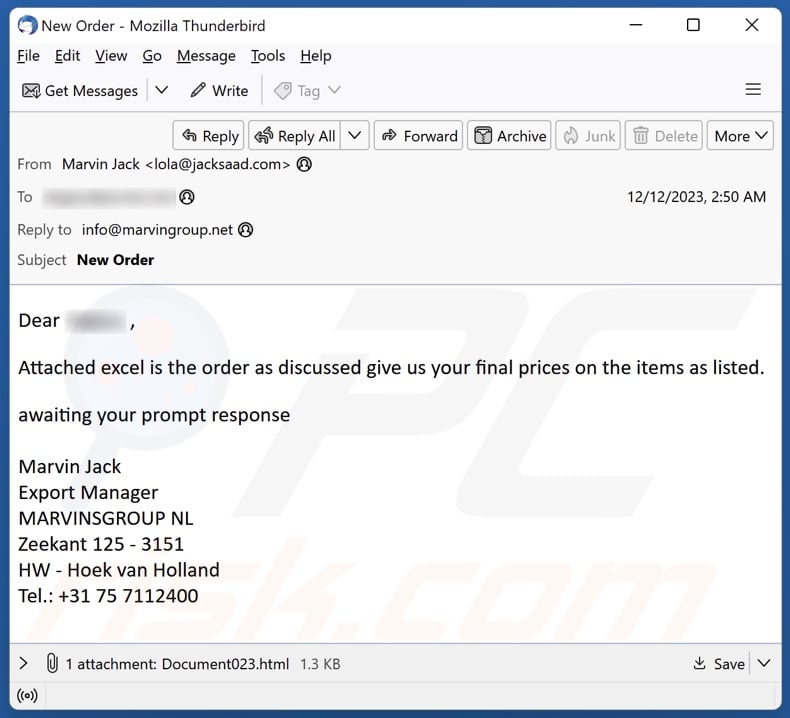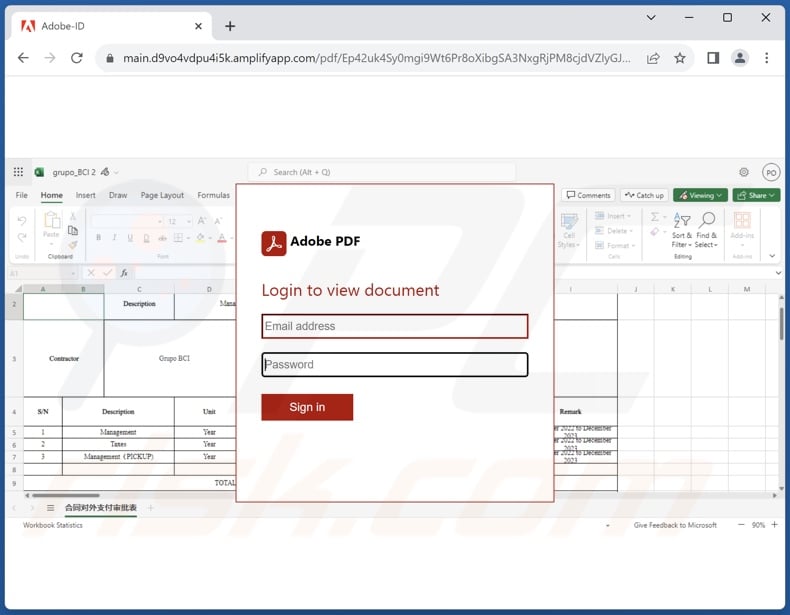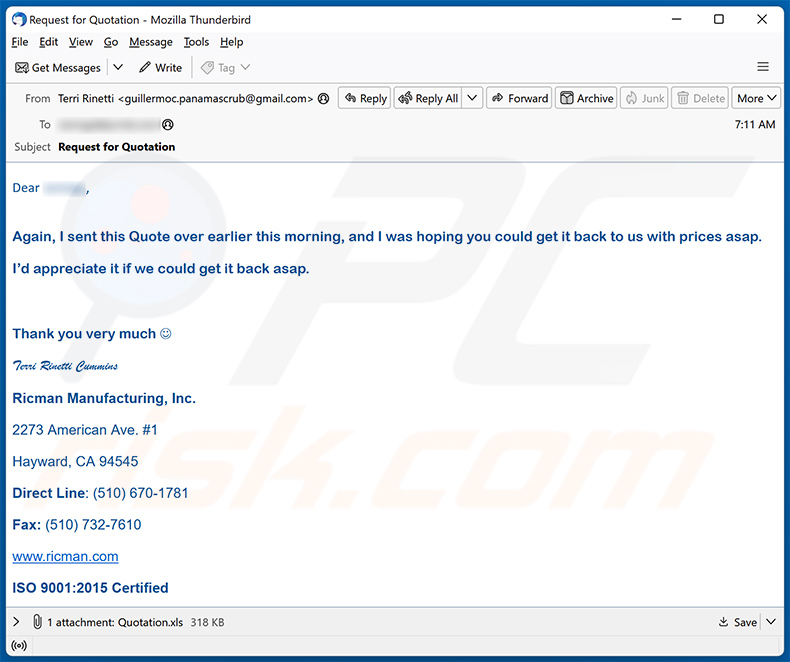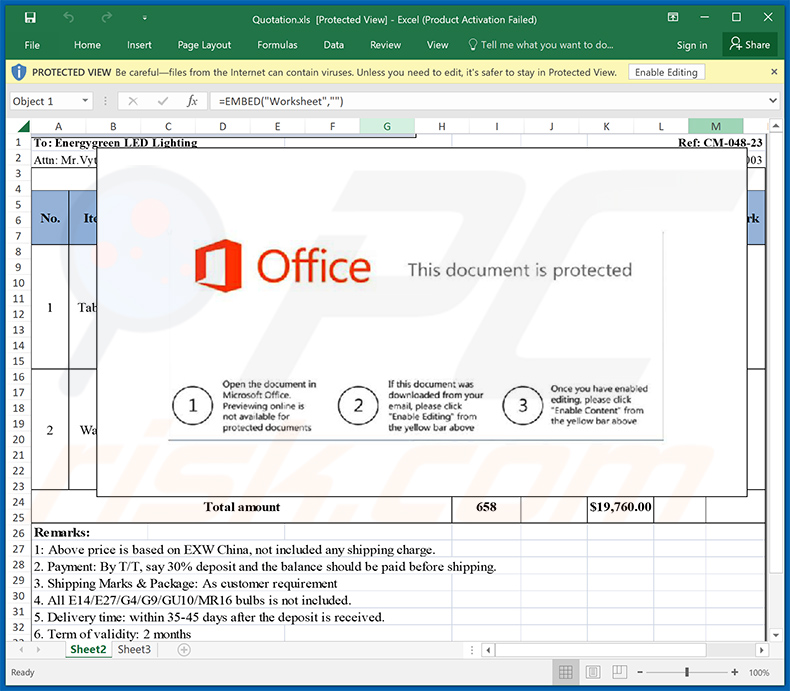Avoid having your email account stolen via fake "Final Price" emails
Phishing/ScamAlso Known As: "Final Price" phishing email
Get free scan and check if your device is infected.
Remove it nowTo use full-featured product, you have to purchase a license for Combo Cleaner. Seven days free trial available. Combo Cleaner is owned and operated by RCS LT, the parent company of PCRisk.com.
What kind of email is "Final Price"?
Upon inspection, we learned that "Final Price" is a spam email promoting a phishing scam. The recipient is lured into disclosing their email account log-in credentials by false claims regarding final prices for listed items.

"Final Price" email scam overview
The scam email with the subject "New Order" (may vary) informs that the attached Excel document supposedly contains the final prices for the ordered items. It must be stressed that this information is false, and the email is not associated with any real named individuals or legitimate entities.
The file attached to this spam letter – "Document023.html" (filename may vary) – redirects the user to a phishing website the moment it is opened. The webpage's background depicts an Excel document that is overlaid by an "Adobe PDF" window requesting the user to log in with their email account.
Victims of this scam risk more than just losing their email. Mail accounts are used to register other content – hence, it may get stolen as well.
To elaborate on the potential misuse, cyber criminals can steal the owners' identities of socially-oriented accounts (e.g., emails, social networking, social media, messengers, etc.) and ask the contacts/friends/followers for loans or donations, promote scams, and proliferate malware by sharing malicious links or files.
Additionally, should any sensitive/confidential content be discovered on compromised data storage or similar platforms – it could be used for blackmail or other nefarious purposes. Furthermore, hijacked finance-related accounts (e.g., online banking, e-commerce, cryptowallets, etc.) can be used to make fraudulent transactions or online purchases.
In summary, by trusting an email like "Final Price" – users can experience severe privacy issues, financial losses, and even identity theft.
If you have already entered your log-in credentials into a phishing webpage – immediately change the passwords of all potentially exposed accounts and contact their official support.
| Name | "Final Price" phishing email |
| Threat Type | Phishing, Scam, Social Engineering, Fraud |
| Fake Claim | Email attachment includes the final prices for items listed. |
| Attachment(s) | Document023.html (filename may vary) |
| Detection Names (Document023.html) | Google (Detected), Ikarus (Phishing.HTML.Doc), Zoner (Probably Heur.HTMLUnescape), Full List Of Detections (VirusTotal) |
| Symptoms | Unauthorized online purchases, changed online account passwords, identity theft, illegal access of the computer. |
| Distribution methods | Deceptive emails, rogue online pop-up ads, search engine poisoning techniques, misspelled domains. |
| Damage | Loss of sensitive private information, monetary loss, identity theft. |
| Malware Removal (Windows) |
To eliminate possible malware infections, scan your computer with legitimate antivirus software. Our security researchers recommend using Combo Cleaner. Download Combo CleanerTo use full-featured product, you have to purchase a license for Combo Cleaner. 7 days free trial available. Combo Cleaner is owned and operated by RCS LT, the parent company of PCRisk.com. |
Phishing spam campaign examples
"Mail Client Manual Settings", "Privacy Policy", "Chunghwa Post", "Glacier Bank", and "Security Info Was Added" are merely some examples of phishing emails we have investigated recently. Various scams are promoted through spam mail, and it is even used to distribute malware.
While infamous for being riddled with errors, these emails can be elaborately disguised as messages from genuine companies, organizations, institutions, service providers, authorities, and other entities.
Due to how prevalent spam mail is and how well-crafted it can be – we strongly advise exercising caution with incoming emails, PMs/DMs, SMSes, and other messages.
How do spam campaigns infect computers?
Cyber criminals commonly use spam campaigns to proliferate malware. Deceptive emails/messages can include infectious files as attachments or download links. These files arrive in various formats, e.g., documents (PDF, Microsoft Office, Microsoft OneNote, etc.), archives (RAR, ZIP, etc.), executables (.exe, .run, etc.), JavaScript, and so on.
Once opened, a virulent file initiates the system infection process. However, some formats can require additional user interaction to jumpstart malware download/installation chains. For example, Microsoft Office files need users to enable macro commands (i.e., editing/content), while OneNote documents require them to click embedded files or links.
How to avoid installation of malware?
We highly recommend treating incoming emails and other messages with care. Attachments or links present in dubious/irrelevant mail must not be opened since they can be malicious. Another recommendation is to use Microsoft Office versions released after 2010 since their "Protected View" mode prevents automatic macro execution.
However, malware is not spread exclusively through spam mail. Therefore, we also advise being vigilant while browsing, as fake and dangerous online content usually appears genuine and innocuous.
It is essential to download only from official and verified sources. Additionally, all programs must be activated and updated using functions/tools provided by legitimate developers, as illegal activation tools ("cracks") and third-party updates can contain malware.
We must emphasize the importance of having a reputable anti-virus installed and kept updated. Security software must be used to perform regular system scans and to remove detected threats/issues. If you've already opened malicious attachments, we recommend running a scan with Combo Cleaner Antivirus for Windows to automatically eliminate infiltrated malware.
Text presented in the "Final Price" spam email letter:
Subject: New Order
Dear - ,
Attached excel is the order as discussed give us your final prices on the items as listed.
awaiting your prompt response
Marvin Jack
Export Manager
MARVINSGROUP NL
Zeekant 125 - 3151
HW - Hoek van Holland
Tel.: +31 75 7112400
Screenshot of the phishing website promoted by the "Document023.html" attachment:

Yet another example of an email from "Final Price" spam campaign:

Text presented within:
Subject: Request for Quotation
Dear -,
Again, I sent this Quote over earlier this morning, and I was hoping you could get it back to us with prices asap.
I’d appreciate it if we could get it back asap.
Thank you very much J
Terri Rinetti Cummins
Ricman Manufacturing, Inc.
2273 American Ave. #1
Hayward, CA 94545
Direct Line: (510) 670-1781
Fax: (510) 732-7610
www.ricman.com
ISO 9001:2015 Certified
Screenshot of the MS Excel document attached to this email. This malicious document is designed to inject malware into the system.

Instant automatic malware removal:
Manual threat removal might be a lengthy and complicated process that requires advanced IT skills. Combo Cleaner is a professional automatic malware removal tool that is recommended to get rid of malware. Download it by clicking the button below:
DOWNLOAD Combo CleanerBy downloading any software listed on this website you agree to our Privacy Policy and Terms of Use. To use full-featured product, you have to purchase a license for Combo Cleaner. 7 days free trial available. Combo Cleaner is owned and operated by RCS LT, the parent company of PCRisk.com.
Quick menu:
- What is "Final Price" phishing email?
- Types of malicious emails.
- How to spot a malicious email?
- What to do if you fell for an email scam?
Types of malicious emails:
![]() Phishing Emails
Phishing Emails
Most commonly, cybercriminals use deceptive emails to trick Internet users into giving away their sensitive private information, for example, login information for various online services, email accounts, or online banking information.
Such attacks are called phishing. In a phishing attack, cybercriminals usually send an email message with some popular service logo (for example, Microsoft, DHL, Amazon, Netflix), create urgency (wrong shipping address, expired password, etc.), and place a link which they hope their potential victims will click on.
After clicking the link presented in such email message, victims are redirected to a fake website that looks identical or extremely similar to the original one. Victims are then asked to enter their password, credit card details, or some other information that gets stolen by cybercriminals.
![]() Emails with Malicious Attachments
Emails with Malicious Attachments
Another popular attack vector is email spam with malicious attachments that infect users' computers with malware. Malicious attachments usually carry trojans that are capable of stealing passwords, banking information, and other sensitive information.
In such attacks, cybercriminals' main goal is to trick their potential victims into opening an infected email attachment. To achieve this goal, email messages usually talk about recently received invoices, faxes, or voice messages.
If a potential victim falls for the lure and opens the attachment, their computers get infected, and cybercriminals can collect a lot of sensitive information.
While it's a more complicated method to steal personal information (spam filters and antivirus programs usually detect such attempts), if successful, cybercriminals can get a much wider array of data and can collect information for a long period of time.
![]() Sextortion Emails
Sextortion Emails
This is a type of phishing. In this case, users receive an email claiming that a cybercriminal could access the webcam of the potential victim and has a video recording of one's masturbation.
To get rid of the video, victims are asked to pay a ransom (usually using Bitcoin or another cryptocurrency). Nevertheless, all of these claims are false - users who receive such emails should ignore and delete them.
How to spot a malicious email?
While cyber criminals try to make their lure emails look trustworthy, here are some things that you should look for when trying to spot a phishing email:
- Check the sender's ("from") email address: Hover your mouse over the "from" address and check if it's legitimate. For example, if you received an email from Microsoft, be sure to check if the email address is @microsoft.com and not something suspicious like @m1crosoft.com, @microsfot.com, @account-security-noreply.com, etc.
- Check for generic greetings: If the greeting in the email is "Dear user", "Dear @youremail.com", "Dear valued customer", this should raise suspiciousness. Most commonly, companies call you by your name. Lack of this information could signal a phishing attempt.
- Check the links in the email: Hover your mouse over the link presented in the email, if the link that appears seems suspicious, don't click it. For example, if you received an email from Microsoft and the link in the email shows that it will go to firebasestorage.googleapis.com/v0... you shouldn't trust it. It's best not to click any links in the emails but to visit the company website that sent you the email in the first place.
- Don't blindly trust email attachments: Most commonly, legitimate companies will ask you to log in to their website and to view any documents there; if you received an email with an attachment, it's a good idea to scan it with an antivirus application. Infected email attachments are a common attack vector used by cybercriminals.
To minimise the risk of opening phishing and malicious emails we recommend using Combo Cleaner Antivirus for Windows.
Example of a spam email:

What to do if you fell for an email scam?
- If you clicked on a link in a phishing email and entered your password - be sure to change your password as soon as possible. Usually, cybercriminals collect stolen credentials and then sell them to other groups that use them for malicious purposes. If you change your password in a timely manner, there's a chance that criminals won't have enough time to do any damage.
- If you entered your credit card information - contact your bank as soon as possible and explain the situation. There's a good chance that you will need to cancel your compromised credit card and get a new one.
- If you see any signs of identity theft - you should immediately contact the Federal Trade Commission. This institution will collect information about your situation and create a personal recovery plan.
- If you opened a malicious attachment - your computer is probably infected, you should scan it with a reputable antivirus application. For this purpose, we recommend using Combo Cleaner Antivirus for Windows.
- Help other Internet users - report phishing emails to Anti-Phishing Working Group, FBI’s Internet Crime Complaint Center, National Fraud Information Center and U.S. Department of Justice.
Frequently Asked Questions (FAQ)
Why did I receive this email?
Spam emails are not personal. These messages are distributed in massive operations – therefore, thousands of users receive identical emails.
I have provided my personal information when tricked by this spam email, what should I do?
If you have provided your log-in credentials – change the passwords of all possibly compromised accounts and inform their official support without delay. And if the disclosed information was of a different personal nature (e.g., ID card details, credit card numbers, etc.) – immediately contact the corresponding authorities.
I have read a spam email but didn't open the attachment, is my computer infected?
No, reading an email is harmless. Systems are infected when malicious attachments or links are opened.
I have downloaded and opened a file attached to a spam email, is my computer infected?
Whether an infection occurred might depend on several factors, such as the purpose of the opened file – phishing vs. malware download/installation – and its format. Executables (.exe, .run, etc.) cause infections almost without fail upon being opened. While some document formats (.doc, .xls, .pdf, .one, etc.) may require additional actions to trigger system infection processes (e.g., enabling macro commands, clicking embedded files/links, etc.).
Will Combo Cleaner remove malware infections present in email attachments?
Yes, Combo Cleaner is designed to scan computers and eliminate all manner of threats. It can detect and remove practically all known malware infections. It must be stressed that since sophisticated malicious programs typically hide deep within systems – performing a full system scan is crucial.
Share:

Tomas Meskauskas
Expert security researcher, professional malware analyst
I am passionate about computer security and technology. I have an experience of over 10 years working in various companies related to computer technical issue solving and Internet security. I have been working as an author and editor for pcrisk.com since 2010. Follow me on Twitter and LinkedIn to stay informed about the latest online security threats.
PCrisk security portal is brought by a company RCS LT.
Joined forces of security researchers help educate computer users about the latest online security threats. More information about the company RCS LT.
Our malware removal guides are free. However, if you want to support us you can send us a donation.
DonatePCrisk security portal is brought by a company RCS LT.
Joined forces of security researchers help educate computer users about the latest online security threats. More information about the company RCS LT.
Our malware removal guides are free. However, if you want to support us you can send us a donation.
Donate
▼ Show Discussion